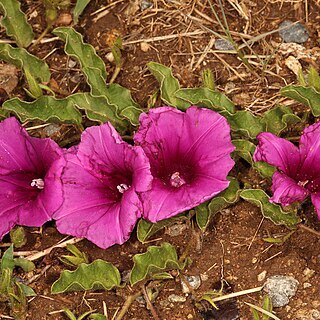Variable perennial with tuberous root, up to 1 m long. Stems annual, up to 2 m long, prostrate, ± zigzag, yellow-brown-hairy, as vegetative parts and calyx. Leaves variable, secund, oblong or elliptic, 20-150 mm long, entire, margins ciliate; petioles shorter than leaf. Inflorescence 1-several-flowered; peduncles shorter than leaves; bracteoles lanceolate, shorter than sepals; pedicels up to 6 mm long. Sepals subequal, ± lanceolate, 12-25 mm long. Corolla funnel-shaped, 35-70 mm long, magenta; midpetaline areas thinly silky hairy. Flowering time Oct.-Apr., mostly Dec., Jan. Fruit a subglobose, glabrous capsule, dark brown, enclosed by sepals, 12-15 mm wide, indehiscent. Seeds 1-4, glabrous, punctate to smooth, grey, 7 mm long.
Perennial herb. Stems procumbent or suberect. Leaves with blade oblong or elliptic, 20150 x 4-80 mm, apex acute to emarginate, covered with strigose yellowish hairs. Flowers: peduncles 1-several-flowered; calyx lobes narrowly ovate to ovate, apices acute or acuminate, outer lobes densely covered with stiff hairs; corolla 35-60 mm long, magenta; Oct.-Apr. Fruit a subglobose, glabrous, indehiscent capsule, 12-15 mm in diameter, loosely enclosed by calyx lobes.
A herb. It lies along the ground. It has broad leaves and can be a climber or scrambler. It keeps growing from year to year. The vines are 2 m long. The leaves are on short almost erect stalks. The leaves vary in shape. The edges are wavy with a fringe of hairs. The tuberous root can be 40 cm thick. The flowers usually occur singly on erect stalks. The fruit is a 1-3 seeded capsule.
Prostrate or suberect perennial herb. Leaf lamina usually oblong or elliptic, covered with strigose yellowish hairs, leaves tending to become more linear in Mpumalanga. Sepals lanceolate to ovate-lanceolate, acute or acuminate with very acute tips, outer ones densely covered with stiff yellowish hairs. Corolla 35-60 mm long. Flowers magenta.
Prostrate perennial herb. Leaf lamina from a broad base oblong to ovate-elliptic, hairy on both surfaces. Flowers in pedunculate few-flowered heads. Sepals 18-35 mm long, lanceolate to ovate. Flowers magenta.

